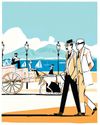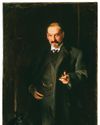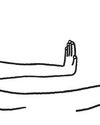
It’s one of the stranger anomalies of French intellectual life that Impressionist painting—by far the most influential of French cultural enterprises— has received so little attention from the most ambitious French critics and philosophers. One can page through André Gide’s journal entries, a lot of them on art, or through Albert Camus’s, and find very little on Claude Monet or Edgar Degas (and much more on the Symbolists, a group that was far easier for a literary man to “get”). Marcel Proust cared passionately for painting, and his heropainter Elstir has touches of Monet, but in order to make him interesting Proust had to model him on the more histrionic James McNeill Whistler, with samplings from a forgotten American painter added in.
The absence isn’t that hard to explain. Impressionism, though profound, isn’t philosophical. Symbolism and Surrealism have an agreeably articulate aesthetic, a body of poems, a point of view. Impressionism is mostly silent. Its implicit credo is empirical and material: there is a stubborn physicality to it— bodies and babies and wheat fields and boulevards. It does not make an argument, except in the way art does, by being art. And yet museums provide the one test that matters most, the test of the crowded room, and the most crowded remain the Impressionists’, marking, as Cyril Connolly once suggested, one of the last instances of a valid myth in Western art: the Impressionist myth of bourgeois pleasure.
This story is from the January 01 - 08, 2023 (Double Issue) edition of The New Yorker.
Start your 7-day Magzter GOLD free trial to access thousands of curated premium stories, and 9,000+ magazines and newspapers.
Already a subscriber ? Sign In
This story is from the January 01 - 08, 2023 (Double Issue) edition of The New Yorker.
Start your 7-day Magzter GOLD free trial to access thousands of curated premium stories, and 9,000+ magazines and newspapers.
Already a subscriber? Sign In

BADDIE ISSUES
\"Wicked\" and \"Gladiator II.\"

LET'S MAKE A DEAL
\"Death Becomes Her\" and \"Burnout Paradise.\"

ANTI HEROES
\"The Franchise,\" on HBO.

FELLOW-TRAVELLERS
The surprisingly sunny origins of the Frankfurt School.

NOW YOU SEE ME
John Singer Sargent's strange, slippery portraits of an art dealer's family.

PARIS FRIEND - SHUANG XUETAO
Xiaoguo had a terror of thirst, so he kept a glass of water on the table beside his hospital bed. As soon as it was empty, he asked me to refill it. I wanted to warn him that this was unhealthy - guzzling water all night long puts pressure on the kidneys, and pissing that much couldn't be good for his injury. He was tall, though, so I decided his insides could probably cope.

WILD SIDE
Is Lake Tahoe's bear boom getting out of hand?

GETTING A GRIP
Robots learn to use their hands.

WITHHOLDING SEX FROM MY WIFE
In the wake of [the] election, progressive women, who are outraged over Donald Trump's victory at the ballot box, have taken to social media with public, vengeful vows of chastity. - The Free Press.

DEADLINE EXTENSION
Old age, reborn.